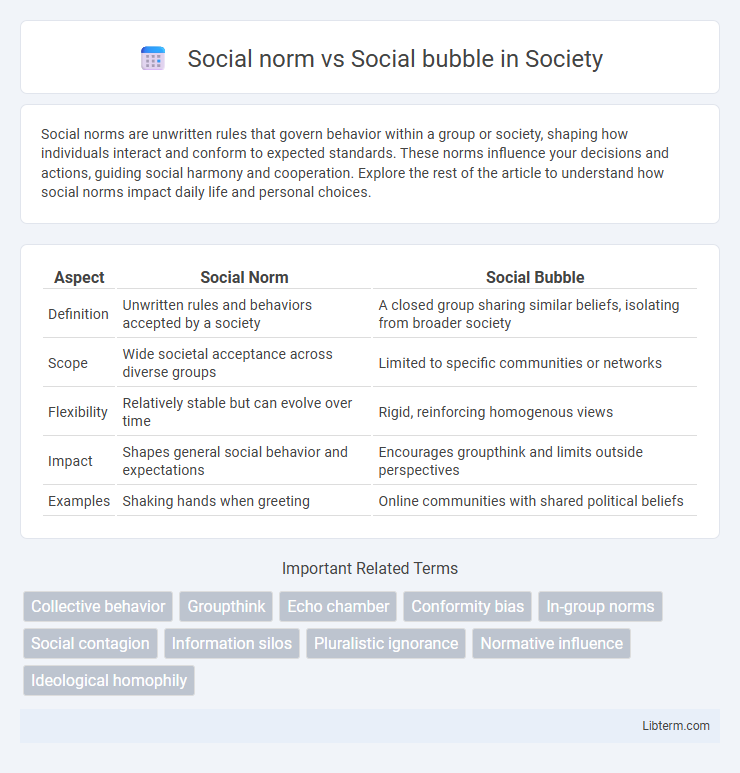Social norms are unwritten rules that govern behavior within a group or society, shaping how individuals interact and conform to expected standards. These norms influence your decisions and actions, guiding social harmony and cooperation. Explore the rest of the article to understand how social norms impact daily life and personal choices.
Table of Comparison
| Aspect | Social Norm | Social Bubble |
|---|---|---|
| Definition | Unwritten rules and behaviors accepted by a society | A closed group sharing similar beliefs, isolating from broader society |
| Scope | Wide societal acceptance across diverse groups | Limited to specific communities or networks |
| Flexibility | Relatively stable but can evolve over time | Rigid, reinforcing homogenous views |
| Impact | Shapes general social behavior and expectations | Encourages groupthink and limits outside perspectives |
| Examples | Shaking hands when greeting | Online communities with shared political beliefs |
Understanding Social Norms: Definition and Importance
Social norms are unwritten rules that govern behavior within a society, shaping expectations and promoting social order. Understanding these norms is crucial for fostering cooperation, reducing conflict, and maintaining cultural cohesion across diverse communities. Unlike social bubbles, which isolate groups from differing perspectives, social norms create a shared framework that guides interactions and supports collective well-being.
What is a Social Bubble? Key Features and Functions
A social bubble is a closely connected group of individuals who interact frequently and share similar beliefs, behaviors, and values, creating an insulated social environment. Key features include selective membership, strong ties within the bubble, and limited interaction with outsiders, which reinforce shared perspectives and social cohesion. Functions of a social bubble include providing emotional support, fostering trust, and maintaining group identity while potentially limiting exposure to diverse viewpoints.
The Origins and Evolution of Social Norms
Social norms originate from repeated behaviors within communities that establish shared expectations for acceptable conduct, evolving through cultural transmission and social reinforcement mechanisms. Unlike social bubbles, which form when individuals cluster in homogeneous groups limiting exposure to diverse viewpoints, social norms develop more broadly across societies to facilitate cooperation and social order. Over time, these norms adapt through collective learning and shifting societal values, reflecting the dynamic interplay between tradition and innovation in human social interactions.
How Social Bubbles Influence our Daily Lives
Social bubbles shape our daily lives by reinforcing shared beliefs and limiting exposure to diverse perspectives, creating environments where conformity to social norms intensifies. These bubbles influence decision-making, social interactions, and information consumption, often leading to echo chambers that amplify existing biases. Understanding the dynamics of social bubbles helps explain behavioral patterns and the persistence of societal norms within specific communities.
Social Norms vs Social Bubbles: Core Differences
Social norms are unwritten rules guiding acceptable behavior within a society, shaping collective expectations and social order. Social bubbles, on the other hand, refer to insulated groups where individuals share similar beliefs, limiting exposure to diverse perspectives and reinforcing homogeneity. The core difference lies in social norms influencing broad social behavior, while social bubbles create echo chambers that constrain social interaction and information flow.
The Role of Social Norms in Shaping Group Behavior
Social norms serve as implicit rules that govern acceptable behavior within a group, significantly influencing individual actions and decisions to maintain social harmony. These unwritten expectations create predictable patterns that reinforce group cohesion and guide behavior consistent with collective values. In contrast, social bubbles form when group members limit interactions to like-minded individuals, which can intensify conformity to specific norms but reduce exposure to diverse perspectives.
Navigating Social Bubbles in a Digital World
Navigating social bubbles in a digital world requires awareness of how algorithm-driven platforms create echo chambers that reinforce existing beliefs while limiting exposure to diverse perspectives. Understanding social norms helps individuals recognize default behaviors within their online communities, enabling deliberate engagement beyond homogeneous groups. Breaking out of these bubbles fosters critical thinking, empathy, and a broader worldview essential for digital literacy and social cohesion.
The Impact of Social Norms and Bubbles on Mental Health
Social norms shape individual behaviors by establishing collective expectations, while social bubbles create insulated environments that reinforce specific beliefs and limit exposure to diverse perspectives. Both can significantly affect mental health; rigid social norms may cause stress from pressure to conform, whereas social bubbles can intensify feelings of isolation or anxiety by restricting social interactions and promoting echo chambers. Understanding the dynamics of these social structures is essential for developing interventions that improve mental well-being and foster inclusive communities.
Breaking Free: Challenging Social Norms and Escaping Bubbles
Breaking free from social norms requires critical examination of inherited beliefs and behaviors that shape group identity and expectations. Escaping social bubbles involves actively seeking diverse perspectives beyond homogeneous communities to prevent echo chambers and cognitive biases. Challenging social conventions enhances personal growth and fosters inclusive, innovative societies.
Building Inclusive Communities Beyond Social Bubbles
Building inclusive communities requires transcending social bubbles that reinforce homogeneity and limit diverse interactions. Social norms often shape behavior within these bubbles, but challenging these norms fosters openness and cross-cultural understanding. Encouraging dialogue and shared experiences across different social groups promotes inclusivity and strengthens community resilience.
Social norm Infographic

 libterm.com
libterm.com